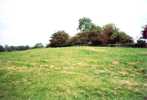For this church:    |
|
 Throsby’s
drawing Throsby’s
drawingof the tower |
Throsby visited in 1790 and wrote, “Here are only two houses and the remains of a church. The church was in use about sixty years since; but now it is about to meet its complete annihilation.” He made a drawing of the ruined tower.
There is an entry in the Wymeswold parish registers made by the rector, Edward Moises, which records, “That on 5th of Feb 1712 I married Mr John Davys of L. Leake in the Co. of Notts. to Mrs Ann Hebb of Quorn Co. Leic. in the P. Church of Thorpe in Glebis in the aforesaid County of Notts.”
Tradition says that the church was Norman and consisted of a chancel and a nave with a small squat tower, the whole building being little more than 60 feet by 18 feet. It is said to have been a sanctuary church.
In 1810, as a boy, John Annabell (1799-1891), living at a nearby farm, climbed the ruined tower to look for jackdaws’ eggs.
The Rev. Thomas Grantham preached his induction sermon in the ruins in 1824, but never officiated in the church thereafter. By 1844, only a grassy mound covered the remaining ruins, upon which the new rector read himself in at his induction. The last incumbent was the Rev. Henry John Hosking, who succeeded Thomas Grantham in 1860. His patron was Samuel Bagnall Wild, Esq. of Costock. No presentation was made after Henry John Hosking died in 1868.
In 1847, Mr John Stokes of Ruddington, steward of the lord of the manor, Mr Mansfield Parkyns of Bunny Hall, told a meeting for the Tithe Commission that there was “no parson at Thorpe at all” and “no church or chapel in the parish” and “we marry and bury at different places, Wymeswold and Wysall, the chief where they attend”.
However, at a later meeting for the Tithe Commission in 1848, John Cox, who was in his 77th year and lived at Wysall, like his father before him, gave evidence under oath that he, his father and grandfather had all occupied land at Thorpe. He recollected “Mr Thoresby”, a clergyman of Thorpe, but couldn’t recollect the name of the one before him. He said, “I heard of Mr Grantham coming and preaching on the ruins of chapel. He read himself in, or was read in. I never saw him more than once. The church was ruinous ever since I can remember. There are only a few stones and rubbish now. There has been no preaching at Thorpe except when Mr Grantham read himself in.”
A footpath leads right round the site where the church once stood. In the 1920s, a group of people from Nottingham came each year and sang hymns there. Who they were or why they came is unknown.
 All
that now remains of the church is a grass-covered mound on the south side of
the Chapel Close and to the north west of Church Site Farm. The site is preserved
as part of the site of the Deserted Medieval Village of Thorpe in the Glebe.
It is grassed over.
All
that now remains of the church is a grass-covered mound on the south side of
the Chapel Close and to the north west of Church Site Farm. The site is preserved
as part of the site of the Deserted Medieval Village of Thorpe in the Glebe.
It is grassed over.
In the 1920s a very old stone-built cottage stood beside the farmhouse. A weather vane on one of the buildings was supposed to have come from the church tower.





